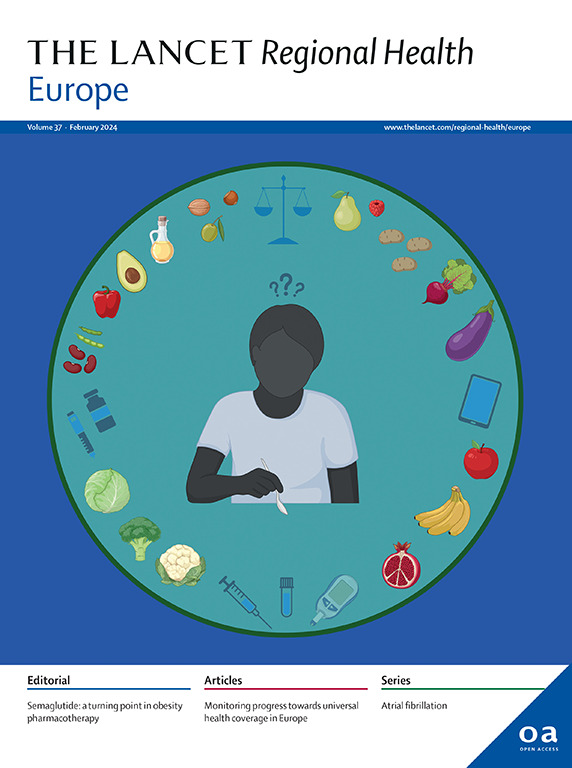Sex differences in risk factors for unsuccessful tuberculosis treatment outcomes in Eastern Europe from 2020 to 2022: a multi-country retrospective cohort study
IF 13
Q1 HEALTH CARE SCIENCES & SERVICES
引用次数: 0
Abstract
Background
Addressing the disproportionate representation between sexes is essential for achieving universal health coverage. Studies on the association between sex and unsuccessful tuberculosis treatment outcomes have shown conflicting results. This study examines this association and analyses sex-stratified risk factors associated with unsuccessful outcomes.
Methods
This retrospective, observational cohort study analysed prospectively collected data from six Eastern European countries from 2020 to 2022. Treatment outcomes were defined using World Health Organization criteria. Uni- and multivariable logistic regression models were used to assess the association between sex and unsuccessful outcomes (‘treatment failure’, ‘lost to follow-up’, ‘died’, or any of these). After propensity score matching females and males, the multivariable analysis was repeated. Risk factors were analysed separately for each sex and compared using interaction terms.
Findings
Among females, 19·5% (n = 290/1490) (95% confidence interval [CI]: 18, 22) achieved an unsuccessful treatment outcome, compared with 30% (n = 1363/4553) (95% CI: 29, 31) among males. In the multivariable analyses, female sex was associated with 32% lower odds of any unsuccessful outcome (adjusted odds ratio [aOR] 0·68, 95% CI: 0·58, 0·80), 36% lower odds of dying (aOR 0·64, 95% CI: 0·51, 0·80), and 37% lower odds of treatment failure (aOR 0·63, 95% CI: 0·47, 0·85). The association between sex and being ‘lost to follow-up’ was not significant. In the propensity score-matched cohort, sex was not associated with unsuccessful outcomes. Risk factors for unsuccessful outcomes were similar for females and males, except that in females aged >65 years, the odds of death were 2·2 times higher (95% CI: 1·1, 4·4).
Interpretation
Male sex was associated with unsuccessful outcomes, including death and treatment failure, but adjusting for socio-demographic and clinical factors, and matching males to females, attenuated the association, suggesting that sex disparities in tuberculosis outcomes may be driven more by behavioural than biological factors. Longitudinal studies are needed to confirm these findings.
Funding
The publication fee was funded by the Civilian Research and Development Foundation (CRDF) under grant #G-202407-72538.
2020年至2022年东欧结核病治疗失败危险因素的性别差异:一项多国回顾性队列研究
背景:解决男女比例不成比例的问题对于实现全民健康覆盖至关重要。关于性别与结核病治疗失败之间关系的研究显示了相互矛盾的结果。本研究检验了这种关联,并分析了与不成功结果相关的性别分层风险因素。方法回顾性、观察性队列研究前瞻性地分析了2020 - 2022年东欧6个国家的数据。治疗结果采用世界卫生组织标准确定。使用单变量和多变量逻辑回归模型来评估性别与不成功结果(“治疗失败”、“随访失败”、“死亡”或其中任何一项)之间的关系。倾向评分匹配男女后,重复多变量分析。对不同性别的危险因素分别进行分析,并使用相互作用项进行比较。在女性中,19.5% (n = 290/1490)(95%可信区间[CI]: 18,22)获得了不成功的治疗结果,而在男性中,这一比例为30% (n = 1363/4553) (95% CI: 29,31)。在多变量分析中,女性与任何不成功结果的几率降低32%相关(调整优势比[aOR] 0.68, 95% CI: 0.58, 0.80),与死亡几率降低36%相关(aOR 0.64, 95% CI: 0.51, 0.80),与治疗失败几率降低37%相关(aOR 0.63, 95% CI: 0.47, 0.85)。性行为和“失去随访”之间的联系并不显著。在倾向评分匹配的队列中,性别与不成功的结果无关。结果不成功的危险因素在女性和男性中相似,但在65岁的女性中,死亡的几率高出2.2倍(95% CI: 1.1.1, 4.4)。男性与不成功的结果相关,包括死亡和治疗失败,但对社会人口统计学和临床因素进行调整,并将男性与女性相匹配,减弱了这种关联,这表明结核病结果的性别差异可能更多地由行为因素而不是生物学因素驱动。需要进行纵向研究来证实这些发现。出版费用由民用研究与发展基金会(CRDF)资助,资助号为G-202407-72538。
本文章由计算机程序翻译,如有差异,请以英文原文为准。
求助全文
约1分钟内获得全文
求助全文
来源期刊

Lancet Regional Health-Europe
Multiple-
CiteScore
19.90
自引率
1.40%
发文量
260
审稿时长
9 weeks
期刊介绍:
The Lancet Regional Health – Europe, a gold open access journal, is part of The Lancet's global effort to promote healthcare quality and accessibility worldwide. It focuses on advancing clinical practice and health policy in the European region to enhance health outcomes. The journal publishes high-quality original research advocating changes in clinical practice and health policy. It also includes reviews, commentaries, and opinion pieces on regional health topics, such as infection and disease prevention, healthy aging, and reducing health disparities.
 求助内容:
求助内容: 应助结果提醒方式:
应助结果提醒方式:


